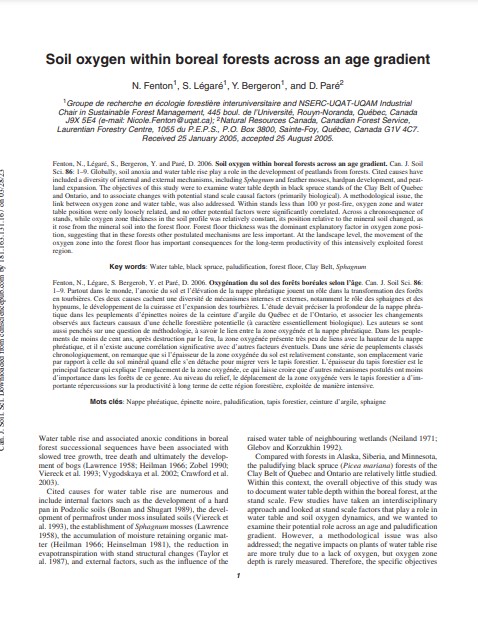Soil oxygen within boreal forests across an age gradient
Bosque Modelo:
Lake Abitibi
Temática:
Conservación
Tipo de documento:
Artículo científico
Resumen
Fenton, N., Légaré, S., Bergeron, Y. and Paré, D. 2006. Soil oxygen within boreal forests across an age gradient. Can. J. Soil Sci. 86: 1–9. Globally, soil anoxia and water table rise play a role in the development of peatlands from forests. Cited causes have included a diversity of internal and external mechanisms, including Sphagnum and feather mosses, hardpan development, and peatland expansion. The objectives of this study were to examine water table depth in black spruce stands of the Clay Belt of Quebec and Ontario, and to associate changes with potential stand scale causal factors (primarily biological). A methodological issue, the link between oxygen zone and water table, was also addressed. Within stands less than 100 yr post-fire, oxygen zone and water table position were only loosely related, and no other potential factors were significantly correlated. Across a chronosequence of stands, while oxygen zone thickness in the soil profile was relatively constant, its position relative to the mineral soil changed, as it rose from the mineral soil into the forest floor. Forest floor thickness was the dominant explanatory factor in oxygen zone position, suggesting that in these forests other postulated mechanisms are less important. At the landscape level, the movement of the oxygen zone into the forest floor has important consequences for the long-term productivity of this intensively exploited forest region.
Información Bibliográfica
Autor:
Fenton, N, S Légaré, Y Bergeron and D Paré.
Revista:
Canadian Journal of Soil Science
Año:
2006
N°:
-
País :
Canadá
Páginas:
1 - 9
Volumen:
86
Idioma:
Ingles
Palabras claves
Water table, black spruce, paludification, forest floor, Clay Belt, Sphagnum





